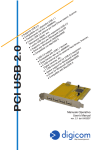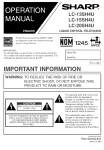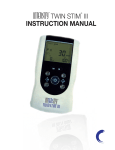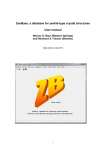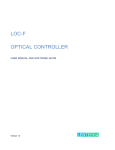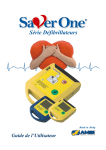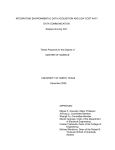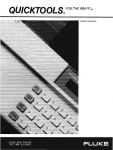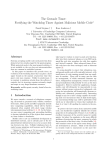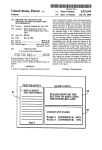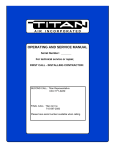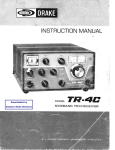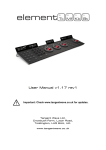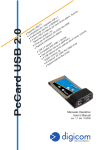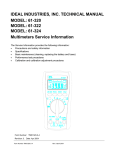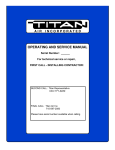Download SELECT Combo INSTRUCTION MANUAL
Transcript
SELECT combo INSTRUCTION MANUAL This manual is valid for the InTENSity Select Combo TENS/IF/MIC/EMS Stimulator TM This user manual is published by Current Solutions™, LLC Current Solutions™, LLC does not guarantee its contents and reserves the right to improve and amend it at any time without prior notice. Amendments may however be published in new editions of this manual. All Rights Reserved. Rev. V1.1 © 2010 : United States Federal Law restricts this device to sale by or on the order of a physician or licensed practitioner Conformity to safety standards Current Solutions™, LLC declares that the device complies with following normative document: IEC60601-1, IEC60601-1-2, IEC60601-2-10,IEC60601-1-4, ISO10993-5, ISO10993-10, ISO10993-1 Table of Contents 1. SAFETY INFORMATION…..…………………………................ 4 1.1 General description 1.2 Medical background 1.3 Indication for use 1.4 Contraindications 1.5 Warnings, Cautions, Adverse Reactions 2. PRESENTATION…………………………………………………..14 2.1 Front and Rear panel 2.2 LCD display 3.SPECIFICATION………………………………………………...…17 3.1 Accessories 3.2 Technical information 3.3 The waveforms of the stimulation programs 4.INSTRUCTIONS FOR USE ………………………………...…… 23 4.1 Battery 4.2 Connect electrodes to lead wires 4.3 Connect lead wires to device 4.4 Electrodes 4.5 Turn ON 4.6 Select the Therapeutic Mode 4.7 Steps to set a new program 4.8 Adjust Channel Intensity 4.9 Safety Lock Feature 4.10 Stop the treatment 4.11 Turn OFF 4.12 Low battery indicator 5.PROGRAM……………………………………..........................… 33 6.CLEANING AND CARE……………….................................….. 33 6.1 Tips for skin care 6.2 Cleaning the device 6.3 Electrodes 6.4 Cleaning the Electrode cables 6.5 Maintenance 7.TROUBLESHOOTING………………………………….………… 37 8.STORAGE……………………………………………................… 38 9.DISPOSAL………………………………………………….........… 38 10.ELECTROMAGNETIC COMPATIBILITY(EMC)TABLES........ 39 11.GLOSSARY OF SYMBOLS ….............................................. 41 12.WARRANTY………………….................................................. 42 1. Safety information 1.1 General InTENSity Select Combo is a portable electrotherapy device featuring four therapeutic modes : Transcutaneous Electrical Nerve Stimulation (T TM pain relief and electrical muscle stimulation. The stimulator sends gentle electrical current to underlying nerves and muscle groups via electrodes applied on the skin. The parameters of the device are controlled by the buttons on the front panel. The intensity level is adjustable according to the needs of patients. 1.2 Medical background EXPLANATION OF PAIN Pain is a warning system and the body’s method of telling us that something is wrong. Pain is important; without it abnormal conditions may go undetected, causing damage or injury to vital parts of our bodies. Even though pain is a necessary warning signal of trauma or malfunction in the body, nature may have gone too far in its design. Aside from its value in diagnosis, long-lasting persistent pain serves no useful purpose. Pain does not begin until the coded message travels to the brain where it is decoded, analyzed, and then reacted to. The pain message travels from the injured area along the small nerves leading to the spinal cord. Here the message is switched to different nerves that travel up the spinal cord to the brain. The pain message is then interpreted, referred back and the pain is felt. EXPLANATION OF TENS Transcutaneous Electrical Nerve Stimulation (TENS) is a noninvasive, drug free method of controlling pain. TENS uses tiny electrical impulses sent through the skin to nerves to modify your pain perception. TENS does not cure any physiological problem; it 4 only helps control the pain. TENS does not work for everyone; however, in most patients it is effective in reducing or eliminating the pain, allowing for a return to normal activity. HOW TENS WORKS There is nothing “magic” about Transcutaneous Electrical Nerve Stimulation (TENS). TENS is intended to be used to relieve pain. The TENS unit sends comfortable impulses through the skin that stimulate the nerve (or nerves) in the treatment area. In many cases, this stimulation will greatly reduce or eliminate the pain sensation the patient feels. Pain relief varies by individual patient, mode selected for therapy, and the type of pain. In many patients, the reduction or elimination of pain lasts longer than the actual period of stimulation (sometimes as much as three to four times longer). In others, pain is only modified while stimulation actually Occurs. You may discuss this with your physician or therapist. EXPLANATION OF EMS Electrical Muscle Stimulation (EMS) is an internationally accepted and proven way of treating muscular injuries. It works by sending electronic pulses to the muscle needing treatment; this causes the muscle to exercise passively. It is a product derived from the square waveform, originally invented by John Faraday in 1831. Through the square wave pattern it is able to work directly on muscle motor neurons. This device has low frequency and in conjunction with the square wave pattern allows direct work on muscle groupings. This is being widely used in hospitals and sports clinics for the treatment of muscular injuries and for the reeducation of paralyzed muscles, to prevent atrophy in affected muscles and improving muscle tone and blood circulation. 5 HOW EMS WORKS The EMS units send comfortable impulses through the skin that stimulate the nerves in the treatment area. When the muscle receives this signal it contracts as if the brain has sent the signal itself. As the signal strength increases, the muscle flexes as in physical exercise. Then when the pulse ceases, the muscle relaxes and the cycle is repeated. The goal of electrical muscle stimulation is to achieve contractions or vibrations in the muscles. Normal muscular activity is controlled by the central and peripheral nervous systems, which transmit electrical signals to the muscles. EMS works similarly but uses an external source (the stimulator) with electrodes attached to the skin for transmitting electrical impulses into the body. The impulses stimulate the nerves to send signals to a specifically targeted muscle, which reacts by contracting, just as it does with normal muscular activity. WHAT IS IF? Interferential Stimulation IF is an anti-inflammatory based treatment modality. Interferential stimulation is characterized by two alternating-current sine waves or square waves of differing frequencies that “work” together to produce an interferential current that is also known as a beat pulse or alternating modulation frequency. One of the two currents is usually held at 4,000 Hz, and the other can be held constant or varied over a range of 4,001 to 4,100 Hz. Because of the frequency, the interferential wave meets low impedance when crossing the skin to enter deep into soft tissues. The interferential currents reportedly can stimulate sensory, motor, and pain fibers. These large impulse fibers interfere with the transmission of pain messages at the spinal cord level. This deep tissue penetration stimulates parasympathetic nerve fibers for increased blood flow and edema reduction. It utilizes the low electric-current to stimulate muscle nerves to achieve the symptomatic relief of chronic intractable pain, post-traumatic pain, and post-surgical pain. 6 WHAT IS MICROCURRENT? Microcurrent stimulation is a type of therapy in which very low current is sent into the cells of the body. Microcurrent is a very faint current that is so small it is measured in millionths of an amp (Microamps). Human cells generate a current that is in the micro amp range which is why you can’t feel it - the current is so low it doesn’t stimulate the sensory nerves. Microcurrent is a physiological electric modality that increases ATP (energy) production in the cells of your body. This dramatically increases the tissue’s healing rate. The immediate response to the correct microcurrent frequency suggests that other mechanisms are involved as well. The exact effects or changes in the tissue are unmistakable; scars will often suddenly soften; trigger points often become less painful within minutes when the “correct” frequency is applied. In many situations the changes seen seem to be long lasting and in many cases permanent. 1.3 Indication for use InTENSity Select Combo TENS/EMS/IF/MIC Stimulator may be used for the following conditions: TM For Transcutaneous Electrical Nerve Stimulator / Interferential/ Microcurrent therapeutic modes (TENS/IF/MIC) 1) Symptomatic relief of chronic pain 2) Post traumatic pain 3) Post surgical pain For Electrical Muscle Stimulation / Neuromuscular Stimulation therapeutic mode (EMS) 1) Relaxation of muscle spasms 2) Increase of blood flow circulation 3) Prevention of disuse atrophy 4) Muscle re-education 5) Maintaining or increasing range of motion 6) Immediate post-surgical stimulation of lower leg muscles to prevent venous thrombosis 7 IMPORTANT SAFETY INFORMATION! Read the instruction manual before operation. Be sure to comply with all “Contraindications”, “Warnings”, “Cautions” and “Adverse reactions” in the manual. Failure to follow instructions can cause harm to user or device. 1.4 Contraindications 1.5 Warnings, Cautions and Adverse Reactions WARNINGS: 9 CAUTIONS: 1) Federal law (USA) restricts this device to sale by or on the order of a physician. 2) For single patient use only. 3) Keep yourself informed of the contraindications. 4) This stimulator not intended for unattended, personal use by patients who have noncompliant, emotionally disturbed, dementia, or low IQ. 5) Read, understand, and practice the warnings, cautions and operating instructions. Know the limitations and hazards associated with using any device. Observe the cautionary and operational decals placed on the unit. Always follow the operating instructions prescribed by your healthcare practitioner. 6) The instruction of use was listed; any improper use may be dangerous. 7) Do not use this device for undiagnosed pain syndromes until consulting a physician. 8) Patients with an implanted electronic device, such as a cardiac pacemaker, implanted defibrillator, or any other metallic or electronic device should not use this device without first consulting a doctor. 9) Stimulation delivered by this device may be sufficient to cause electrocution. Electrical current of this magnitude must not flow through the thorax or across the chest because it may cause a cardiac arrhythmia. 10) Do not place electrodes on the front of the throat as spasm of the Laryngeal and Pharyngeal muscle may occur. Stimulation over the carotid sinus (neck region) may close the airways, make breathing difficult, and may have adverse effects on the heart rhythm or blood pressure. 11 14) Electrode placement and stimulation settings should be based on the guidance of prescribing practitioner. 15) Effectiveness is highly dependent upon patient selection by a person qualified in the management of pain afflicted patients. 16) Isolated cases of skin irritation may occur at the site of the electrode placement following long-term application. If this occurs, discontinue use and consult your physician. 17) The electrodes are only to be placed on healthy skin. Avoid skin irritation by ensuring that good contact is achieved between electrodes and skin. 18) If the stimulation levels are uncomfortable or become uncomfortable, reduce the stimulation Intensity to a comfortable level and contact your physician if problems persist. 19) This device should not be used while driving, operating machinery, close to water, or during any activity in which involuntary muscle contractions may put the user at undue risk of injury. 20) Never use the device in rooms where aerosols (sprays) are used or pure oxygen is being administered. 21) Do not use it near any highly flammable substances, gases or explosives. 22) Do not use this device at the same time as other equipment which sends electrical pulses to your body. 23) Do not confuse the electrode cables and contacts with your headphones or other devices, and do not connect the electrodes to other devices. 24) Do not use sharp objects such as pencil point or ballpoint pen to operate the buttons on the control panel. 25) Inspect Applicator cables and associated connectors before each use. 26) Turn the device off before applying or removing electrodes. 27) Electrical stimulators should be used only with the leads and electrodes recommended for use by the manufacturer. 28) This device has no AP/APG protection. Do not use it in the presence of explosive atmosphere and flammable mixture. 12 Adverse Reactions: 1) Skin irritation from the electrode gel and electrode burns are potential adverse reactions. If skin irritation occurs, discontinue use and consult your physician. Note: Always use electrodes that are legally marketed and sold in the United States under 510K guidelines. 2) If the stimulation levels are uncomfortable, reduce the stimulation Intensity to a comfortable level and contact your physician if any problems persist. 13 2. Presentation 2.1 Front and Rear Panel 1) 2) 3) 4) 5) 6) 7) Output socket: electric signal output after connection of the cable with adhesive electrodes on channel 1. Output socket: electric signal output after connection of the cable with adhesive electrodes on channel 2. Increasing the output intensity of channel 1 [▲]. Use to set the application program and the parameter of the waveform in the setting state. Decreasing the output intensity of channel 1 [▼]. Use to set the application program and the parameter of the waveform in the setting state and to unlock the current treatment program. Therapeutic mode selection. Stop the treatment. Exit setting mode to return to the user interface. LCD display: Shows the operating state of the device. Increasing the output intensity of channel 2 [▲]. Use to set the application program and the parameter of the waveform in the setting state. 14 8) 9) 10) 11) 12) 13) Decreasing the output intensity of channel 2 [▼]. Use to set the application program and the parameter of the waveform in the setting state. Use to unlock the current treatment program. Parameter Selection: press the button to enter setting state; you can select the different parameters in conjunction with [▲] and [ ▼]. Press [ ] to turn ON. Press [ ] button and hold for approximately 3 seconds to turn off the device. Belt Clip. The battery compartment cover for user access. Adapter Receptacle. 2.2 LCD display 1) 2) 3) 4) 5) 6) 7) 8) Displays therapeutic mode. Displays therapeutic program for TENS and EMS therapeutic mode. Displays therapeutic program for IF and MIC therapeutic mode or displays the cycle time for TENS, IF and MIC therapeutic mode in setting state. Timer symbol. EMS waveform of ramp up and ramp down time. Display of waveform pulse width. Displays channel 1. Display of the output intensity for channel 1 (CH1); Display of waveform pulse width or EMS waveform of contraction (working) time in setting state. 3. Specification 3.1 Accessories 3.2 Technical information Channel Power supply Dual, isolated between channels 9.0 V Alkaline DC -1 *6LR61 battery Adapter output: 9.0Vdc, 800mA(optional) 5°C to 40°C (41℉ to 104℉)with a relative Operating conditions humidity of -10°C to 50°C (14℉ to 122℉)with a relative Storage conditions humidity of Dimensions 4.5×2.55×0.9 inches(L*W*H) Weight Tolerance 0.28 lbs(With battery) There may be a ±5% tolerance of all setting and ±10% Adjustable from 1 to 60 minutes or continuous. Adjusts in 1 minute steps. Treatment time countdown is automatic. The amplitude level will be reset to 0mA when the amplitude level is 12mA or greater and an open circuit at either channel is detected. Timer Electrode Detection Function Technical specifications for Transcutaneous Electrical Nerve Stimulator (TENS) mode Waveform Mono-phase square pulse wave Pulse amplitude Adjustable, 0~105mA peak at 1000 ohm Load each channel, 1mA/Step. Pulse Width Adjustable,from 50 to 300us microseconds ,10μS/step Pulse Rate Adjustable, from 1 to 150 Hz , 1 Hz/step Burst (B) Burst rate: Adjustable, 0.5 ~ 5Hz Pulse width adjustable, 50~300μS Frequency fixed = 100 Hz Normal (N) The pulse rate and pulse width are adjustable. It generates continuous stimulation based on the setting value. Pulse Width Modulation (M) The pulse width is automatically varied in a cycle time. The pulse width is decreased from its original setting to 60% in setting cycle time, and then increased from 60% to its original setting in nest setting cycle time. In this program, pulse rate (1 to 150Hz), pulse width (50 to 300us) and cycle time (5 to 30 sec) are fully adjustable. Pulse Rate The pulse rate is automatically varied in a cycle Modulation (M1) time. The pulse rate is decreased from its original setting to 60% in setting cycle time, and then increased from 60% to its original setting in nest setting cycle time. In this program, pulse rate (1 to 150Hz), pulse width (50 to 300us) and cycle time (5 to 30 sec) are fully adjustable. 18 Technical specifications for Electrical Muscle Stimulation (EMS) mode Waveform: Pulse amplitude Pulse Width Pulse Rate Contraction time Relaxation (OFF) Ramp time Synchronous (S) Alternate (A) Delay (D) Mono-phase square pulse wave Adjustable, 0~105mA peak at 1000 ohm Load each channel, 1mA/Step. Adjustable, from 50 to 300μS microseconds, 10μS/step. Adjustable, from 1 to 150 Hz, 1 Hz/step Adjustable, 1~60 seconds , 1 Sec./ step Adjustable, 0~60 seconds , 1 Sec./ step Adjustable, 1~6 seconds, 1 Sec. / step, The “On” time will increase and decrease in the setting value. Stimulation of both channels occurs synchronously. The“ON” time including “Contraction”, “Ramp Up” and “Ramp Down” time. ON TIME=Contraction + Ramp up + Ramp dow The Stimulation of the CH2 will occur after the 1st working of CH1 is completed. In this program, The “ON” time including “Contraction”, “Ramp Up” and “Ramp Down” time. The OFF Time should be equal or more than the ON Ti TI Ramp down OFF TIME≥ON TIME The Stimulation of the CH2 will occur after the 1st operation of CH1 is started+ Delay Time. In this program, The “ON” time including “Contraction”, “Ramp Up” and “Ramp Down” time. The OFF Time should be equal or more than the ON Time + Delay Time. ON TIME=Contraction + Ramp up + Ramp down Technical specifications for Interferential (IF) mode Waveform Pulse amplitude Pulse Rate Phase Width Bi-phase square pulse Adjustable, 0~70mA peak to peak at 1000 ohm Load Channel 1 – Fundamental frequency: 4000 Hz fixed Channel 2 – Selectable frequency: 4001 to 4150 Hz Interference frequency: 1 to 150 Hz. 125μS Technical specifications for Microcurrent (MIC) mode Waveform Pulse amplitude Mono-phase square pulse wave Adjustable, 0~0.7mA peak at 1000 ohm Load each channel, 0.01mA/Step Pulse Width (P.W.) Adjustable, from 2 to 200ms, 1ms/step Pulse Rate (P.R.) Adjustable, from 1 to 150 Hz, 1 Hz/step Constant(P1) Constant stimulation based on setting value. Only pulse width, pulse rate and timer are adjustable in this program. “Constant” is equal to the “Normal” mode of a TENS therapeutic mode The pulse width is automatically varied in a cycle time.The pulse width is decreased from its original setting to 60% in setting cycle time, and then increased from 60% to its original setting in nest setting cycle time. In this program, pulse rate (1 to 150Hz), pulse width (2 to 200ms) and cycle time (5 to 30 sec) are fully adjustable. The pulse rate is automatically varied in a cycle time. The pulse rate is decreased from its original setting to 60% in setting cycle time, and then increased from 60% to its original setting in nest setting cycle time. In this program, pulse rate (1 to 150Hz), pulse width (2 to 200ms) and cycle time (5 to 30 sec) are fully adjustable. Pulse Width Modulation (P2) Pulse Rate Modulation (P3) 20 3.3 The waveforms of the stimulation programs Burst (B) Normal (N) Pulse Width Modulation Pulse Rate Modulation Synchronous(S) Alternate (A) Delay (D) Interferential Microcurrent (Constant) 22 4. Instructions for use 4 .1 Battery 4.1.1 Check/Replace the battery Over time, in order to ensure the functional safety of device, the battery must be periodically changed. 1) Slide the battery compartment cover and open. 2) Insert the 9V battery into the battery compartment. 3) Make sure you are installing the battery properly. Be sure to match the positive and negative ends of the battery to the marking in the battery compartment of the device. 4) Press and pull down following the direction of the arrow indicated on the photo. 5) Replacing the battery compartment cover and press to close 6) If replacing the battery, you should slide the battery compartment cover and open. Pull up the battery following the direction of the arrow indicated on the photo. And insert the 9V battery according to the above steps 2 - 5. 4.1.2 Disposal of battery Spent batteries do not belong in household waste. Dispose of the battery according to the current federal, state and local regulations. Caution: 1) Battery may be fatal if swallowed. Therefore, keep the battery and the product out of the range of children, if a battery was swallowed, consult a physician immediately. 2) If a battery has leaked, avoid contact with skin, eyes and mucus membranes. Rinse the affected spots with clear water immediately and contact a physician right away. 3) Battery may not be charged, dismantled, thrown into fire or short-circuited. 4) Protect battery from excess heat; Take the battery out of the product if they are spent or in case you no longer use the article. This prevents damage caused by leaking battery. 5) Always replace the same type battery. 4.2 Connect electrodes to lead wires Insert the lead wire connector into electrode connector (standard 0.08 inch female connection). Make sure there are no bare metal of the pins exposed. Caution: Always use the electrodes with the requirements of the IEC/EN60601-1,ISO10993-1/-5/-10 and IEC/ EN60601-1-2, such as with CE mark, or which are legally marketed in the US under 510(K) listing. 4.3 Connect lead wires to device 1) Before proceeding to this step, be sure the device is completely turned OFF. 2) Insert the wires provided with the system into the jack sockets located on top of the device. 3) Holding the insulated portion of the connector, push the plug end of the wire into one of the jacks (see drawing); one or two sets of wires may be used. 4) This device has two output receptacles controlled by Channel 1 and Channel 2 at the top of the unit. You may choose to use one channel with one pair of lead wires or both channels with two pairs of lead wires. Using both channels gives the user the advantage of stimulating two different areas at the same time. Caution: Do not insert the plug of the patient lead wire into any AC power supply socket. 24 4.4 Electrode 4.4.1 Electrode options The electrodes are disposable and should be routinely replaced when they start to lose their adhesive nature. If you are unsure of your electrodes adhesive properties, order replacement electrodes. Replacement electrodes should be re-ordered through or on the advice of your physician to ensure proper quality. Follow application procedures outlined in electrode packing, to maintain optimal stimulation and to prevent skin irritation. 4.4.2 Place electrodes on skin Apply electrodes to the exact site indicated by your physician or therapist. Before applying electrodes, be sure the skin surface over which electrodes are placed is thoroughly clean and dry. Make sure the electrodes are pressed firmly to the skin and make good contact between the skin and the electrodes. Place the electrodes over the skin; attach them properly, firmly, and evenly. Caution: 1) Before applying the self-adhesive electrodes, it is recommended to wash and degrease and dry the skin. 2) Do not turn on the device when the self-adhesive electrodes are not positioned on the body. 3) Never remove the self-adhesive electrodes from the skin while the device is turned on. 4) It is recommended that, at minimum, 1.5” x 1.5” selfadhering based, square electrodes are used at the treatment area 25 4.4.3 Electrode placement The placement of electrodes can be one of the most important parameters in achieving success with therapy. Of utmost importance is the willingness of the physician to try the various styles of electrode placement to find which method best fits the needs of the individual patient. Every patient responds to electrical stimulation differently and their needs may vary from the conventional settings suggested here. If the initial results are not positive, speak to your physician about alternative stimulation settings and/or electrode placements. Once an acceptable location has been achieved, mark down the electrode sites and the device settings, so the patient can easily continue treatment. 4.5 Turn on Before using the device for the first time, you are strongly advised to take careful note of the contraindications and safety measures detailed at the beginning of this manual (Safety information), as this powerful equipment is neither a toy nor a gadget! In order to turn on the device, PRESS and RELEASE the [ ] button. The operation page appears on the screen. 4.6 Select the Therapeutic Mode There are 4 therapeutic modes available –TENS, EMS, IF, and MIC. The therapeutic mode can be selected by pressing the [M] control. Caution: Consult your physician for your suitable therapeutic mode 4.7 Steps to Set a New Program 4.7.1 TENS Setting Press the [S] button cycle to enter the setting state. The settings can be adjusted according to the following steps: 1) Set the Therapeutic Program There are 4 programs in TENS therapeutic mode available –Burst (B), Normal (N), Pulse Width Modulation (M), and Pulse Rate Modulation (M1). The therapeutic program can be selected by pressing the [▲] and [▼] button. When you choose to “B” program, program “B” outside of the box will be flashing. 2) Set Cycle Time (Optional) Cycle time is adjustable from 5 to 30 seconds. Only modulation has this parameter setting. Press [S] button cycle to enter this menu, and then press the [▲]and [▼]button to adjusting the setting. 3) Set Timer Press [S] button cycle to enter this setting. The treatment time is adjustable from 1 to 60 minutes or Continuous. Press [▲] or [▼] button control to adjust setting. You can set the timer to “Continuous” mode by pressing the [▲] control when it shows 60 minutes. The output will be shut off when time is up. 4) Set Pulse Width Pulse Width is adjustable from 50 uS to 300 uS. Press [S] button to enter this menu, then press [▲] or [▼] button to adjust the setting. 5) Set Pulse Rate Pulse rate is adjustable from 1 Hz to 150 Hz (0, 5 Hz to 5 Hz for Burst). Press [S] button cycle to enter this menu, and then press [▲] or [▼] button to adjust the setting. 27 4.7.2 EMS Setting Press the [S] button cycle to enter the setting state. The settings can be adjusted according to the following steps: 1) Set the Therapeutic Program There are 3 programs in EMS therapeutic mode available – Synchronous, Alternate and Delay. The therapeutic program can be selected by pressing the [▲] and [▼] button. When you choose to [S] program, program [S] outside of the box will be flashing. 2) Set Timer Press [S] button cycle to enter this setting. The treatment time is adjustable from 1 to 60 minutes or Continuous. Press [▲] or [▼] control to adjust setting. You can set the timer to “Continuous” mode by pressing the [▲] button when it shows 60 minutes. The output will be shut off when time is up. 3) Set Pulse Width The pulse width determines the length of time. Each electrical signal is applied through the skin, which controls the strength and sensation of the stimulation. Press [S] button cycle to enter this setting. The pulse width is adjustable from 50 to 300 uS. Press [▲] or [▼] button to adjust the setting. 4) Set Pulse Rate The pulse rate determines how many electrical impulses are applied through the skin each second. Press [S] button cycle to enter this menu. Adjust the setting by pressing the [▲] or [▼] buttons. The pulse rate is adjustable from 1 Hz to 150 Hz. 5) Set Delay Time (Optional) Delay time is adjustable form 1 to 10 seconds. Only the “Delay” therapeutic program has this parameter setting. Press [S] button cycle to enter this menu, and then press the [▲] and [▼] button to adjusting the setting. 6) Set Ramp Time The ramp time controls the time of output current that increase from 0 to the setting level, and from the setting value to 0. When the ramp time is set, each contraction may be ramped up and down in order that the signals come on and come off gradually and smoothly. The ramp time is adjustable from 1 to 6 seconds. 7) Set Contract Time The contract Time controls the time of stimulation and can be adjusted. Press [S] button cycle to enter this menu, and then press the [▲] and [▼] button to adjust the setting. Both channels’ stimulation is cycled on and off by the contraction and relaxation settings. The range is adjustable from 1 to 60 seconds. Caution: Contract time does not include the ramp up and ramp down time, ON time=Ramp up + Contract time + Ramp down. 8) Set Relaxation (OFF) time The Off Time controls the time of relaxation and can be adjusted. Press [S] button cycle to enter this menu, and then press the [▲] and [▼] button to adjusting the setting. Both channels’ stimulation is cycled on and off by the contraction and relaxation settings. The range is adjustable from 0 to 60 seconds. In Alternate program, the OFF Time should be equal or more than the ON Time. (OFF TIME ≥ ON TIME) 4.7.3 IF Setting Press the [S] button to enter the setting state. The settings can be adjusted according to the following steps: 1) Set the Therapeutic Program There are 4 programs in IF therapeutic mode available. The therapeutic program can be selected by pressing the [▲] and [▼] button. The mode you selected will show up on the top of liquid crystal display. 2) Set Timer Press [S] button cycle to enter this setting.The treatment time is adjustable from 1 to 60 minutes or Continuous. 29 Press [▲] or [▼] control to adjust setting. You can set the timer to “Continuous” mode by pressing the [▲] button when it shows 60 minutes. Its output will be shut off when time is up. 3) Set Interference frequency (optional) Channel 1 has 4000 Hz fixed Fundamental frequency. Channel has selectable frequency from 4001 to 4150Hz; Interference frequency is adjustable form 1 Hz to 150 Hz. Only “P4” has this parameter setting. Press [S] button cycle to enter this menu, and then press the [▲] and [▼] button to adjusting the setting. 4) Set Cycle Timer Cycle time is adjustable form 5 to 30 seconds. Press [S] button cycle to enter this menu, and then press the [▲] and [▼] button to adjusting the setting. 4.7.4 Microcurrent Setting Press the [S] button cycle to enter the setting state. The settings can be adjusted according to the following steps: 1) Set the Therapeutic Program There are 3 programs in MIC therapeutic program available: Constant, Pulse Width Modulation, and Pulse Rate Modulation. The therapeutic program can be selected by pressing the [▲] and [▼] button. The mode you selected will show up on the top of LCD Display. 2) Set Timer Press [S] button cycle to enter this setting. The treatment time is adjustable from 1 to 60 minutes or Continuous. Press [▲] or [▼] button control to adjust setting. You can set the timer to “Continuous” mode by pressing the [▲] control when it shows 60 minutes. Its output will be shut off when time is up. 3) Set Pulse Width Pulse Width is adjustable from 2ms to 200ms. Press [S] button cycle to enter this menu, then press [▲] or [▼]button to adjust the setting. 4) Set Pulse Rate Pulse rate is adjustable from 1 Hz to 150 Hz. Press [S] button cycle to enter this menu, and then press [▲] or [▼]button to adjust the setting. 5) Set Cycle Time (Optional) Cycle time is adjustable form 5 to 30 seconds. Only modulation mode has this parameter setting. Press [S] button cycle to enter this menu, and then press the [▲] and [▼] button to adjusting the setting. 4.8 Adjust Channel Intensity Press the intensity control button ([▲] and [▼]) to control the intensity output. Slowly press the intensity button control until you reach the setting recommended by your physician or therapist. Repeat for the other channel, if both channels are to be used. Caution: 1) If the stimulation levels are uncomfortable or become uncomfortable, reduce the stimulation intensity to a comfortable level and contact your medical practitioner if problems persist. 2) TENS, EMS and IF therapeutic mode. If the electrodes are not placed firmly on skin or the device is not connected to the electrodes and the stimulator’s output intensity surpasses 12mA, the intensity will automatically reset to 0mA. 4.9. Safety Lock Feature The Safety Lock Feature automatically activates after there is no operation in the panel for 30 seconds by locking out the ability to press the buttons. This is a safety feature to prevent accidental changes to your settings and to prevent accidental increases to the intensity levels. You can press either one of the [▼] buttons to unlock the device. 31 4.10. Stop the treatment When you have activated the treatment timer,you can press the [M] button or the [▼] button to control stop the treatment. Caution: Default state, if the button is locked, you can press only one of the [▼] buttons to unlock, and then press the [M] button or the [▼] button to control stop the treatment. 4.11. Turn OFF PRESS [ ] button and HOLD for approximately 3 seconds to turn OFF the device. Caution: 1) If there is no operation in the panel for 2 minutes in the waiting state, the device turns off automatically. 2) In shutdown state, keep pressing the channel 2 [▼] first, and then press [ ] button at the same to restore factory parameter settings 4.12. Low battery indicator When the low power indicator flashes, the device will be turns off automatically, the battery should be replaced with a new one as soon as possible. However, the unit may continue to operate for an extended period of time depending on the setting and intensity level. 5. Program Mode Program Modulation Frequency Method Pulse Width Treatment time 1-150Hz 50-300us 50-300us 1-60min,continuous 1-60min,continuous 1-150Hz 50-300us 1-60min,continuous 1-150Hz 50-300us 1-60min,continuous 1-150Hz 50-300us 1-60min,continuous 4kHz 4001-4010Hz 125us 1-60min,continuous 125us 1-60min,continuous modulation 4kHz 4001-4150Hz 4kHz 4080-4150Hz modulation 4kHz 4001-4150Hz 125us 1-60min,continuous 1-150Hz 2-200ms 1-60min,continuous 1-150Hz 2-200ms 1-60min,continuous TENS d l ti modulation EMS mode Mode modulation IF MIC modulation modulation modulation 125us 1-60min,continuous 6. Cleaning and Care 6.1 Tips for skin care To avoid skin irritation, especially if you have sensitive skin, follow these suggestions: 1) Wash the area of skin where you will be placing the electrodes, using mild soap and water before applying electrodes, and after taking them off. Be sure to rinse soap off thoroughly and dry skin well. 2) Excess hair may be clipped with scissors; do not shave stimulation area. 33 3) Wipe the area with the skin preparation your clinician has recommended. Let this dry. Apply electrodes as directed. 4) Many skin problems arise from the “pulling stress” from adhesive patches that are excessively stretched across the skin during application. To prevent this, apply electrodes from center outward; avoid stretching over the skin. 5) To minimize “pulling stress”, tape extra lengths of lead wires to the skin in a loop to prevent tugging on electrodes. 6) When removing electrodes, always remove by pulling in the direction of hair growth. 7) It may be helpful to rub skin lotion on electrode placement area when not wearing electrodes. 8) Never apply electrodes over irritated or broken skin. 6.2 Cleaning the device 1) Remove the battery from the device every time when you clean the device. 2) Clean the device after use with a soft, slight moistened cloth. In case of more extreme soiling you can also moisten the cloth with mild soapy water. 3) Do not use any chemical cleaners or abrasive agents for cleaning. 6.3 Electrodes 1) Use the device only with the leads and electrodes provided by the manufacturer. Use only the electrode placements and stimulation settings prescribed by your physician or therapist. 2) It is recommended that, at minimum, 1.5” x 1.5” self-adhering electrodes should be used at the treatment area. 3) Inspect your electrodes before every use. Replace electrodes as needed. Reusable electrodes may cause slight skin irritation, lose adhesion properties and deliver less stimulation if overused. 34 To use these electrodes: 1) 2) 3) Attach the electrode to the lead wire. Remove the protective backing from the electrode surface. Do not throw away the protective backing because it is reused after the treatment session has been completed. Place the tacky surface to the prescribed skin area by pressing the electrode firmly against the skin. To remove your electrodes: 1) Lift the corner of the electrode and gently remove it from the skin. 2) It may be helpful to improve repeated application by spreading a few drops of cold water over the adhesive and turn the surface up to air dry. Over Saturation with water will reduce the adhesive properties. 3) Between uses, store the electrodes in the resealable bag in a cool dry place. Caution: 1) Do not pull on the electrode wire. Doing so may damage the wire and electrode. 2) Do not apply to broken skin. 3) The electrodes should be discarded when they are no longer adhering. 4) The electrodes are intended for single patient use only. 5) If irritation occurs, discontinue use and consult your clinician. 6) Read the instructions for use of self-adhesive electrodes before application. 35 7) Always use the electrodes with the requirements of the IEC/EN60601-1, ISO10993-1/-5/-10 and IEC/ EN60601-1-2, such as with CE mark, or are legally marketed in the US under 510(K) procedure. 6.4 Cleaning the Electrode's cords Clean the electrode cords by wiping them with a damp cloth. Coating them lightly with talcum powder will reduce tangles and prolong the life. 6.5 Maintenance 1) Maintenance and all repairs should only be carried out by an authorized agency. The manufacturer will not be held responsible for the results of maintenance or repairs by unauthorized persons. 2) The user must not attempt any repairs to the device or accessories. Please contact the retailer for repair. 3) Opening of the equipment by unauthorized agencies is not allowed and will terminate any claim to warranty. 4) Check the unit before each use for signs of wear and/or damage. Replace worn items as required. 7. Troubleshooting If your device does not seem to be operating correctly, refer to the chart below to determine what may be wrong. Should none of these measures correct the problem, the device should be serviced. Proble Display fails to light up Possible Cause Battery contact failure Solution 1. Try fresh batteries. 2. Ensure batteries are inserted correctly. Check the following: • All contacts are in place • All contacts are not broken Stimulation weak Electrodes / Lead Wires Replace and re-connect 1. Dried out or contaminated Follow instruction manual 2. Placement of lead wires Follow instruction manual 3. Old/worn/damaged lead Replace wires or electrodes Stimulation is uncomfortable Intensity is too high Electrodes are too close together Decrease intensity. Reposition the electrodes. Damaged or worn electrodes or lead wires Replace. Electrode active area size is too small. Lead wires Replace electrodes with ones that have an active area no less than 1. Verify connection is secure & firmly seated 2. Turn down the intensity. Rotate lead wires in socket 90°. If still intermittent, replace lead wire. 3. If still intermittent after replacing lead wire, a component may have failed. Call the repair department. Program option in use Some programs will seem intermittent. This is expected. Refer to the Program Option Controls in the Operation section for a description of the program option. Improper electrode and applicator placement Unknown Reposition electrode and applicator Contact clinician. Intermittent output Stimulation is ineffective. 37 8. Storage 1) For a prolonged pause in treatment, store the device in a dry room and protect it against heat, sunshine and moisture and remove the battery. 2) Store the device in a cool, well-ventilated place 3) Never place any heavy objects on the device. 9. Disposal Used fully discharged batteries must be disposed of in a specially labeled collection container, at toxic waste collection points or through an electrical retailer. Please dispose of the device in accordance with the law. 38 10. Electromagnetic Compatibility (EMC) Tables Guidance and manufacturer’s declaration - electromagnetic emissions The device is intended for use in the electromagnetic environment specified below. The Emissions test Compliance Electromagnetic environment - guidance RF emissions Group 1 The device uses RF energy only for its internal function. Therefore, its RF emissions CISPR 11 are very low and are not likely to cause any interference in nearby electronic equipment. RF emissions CISPR11 Class B Harmonic emissions lEC 61000-3-2 Voltage fluctuations / flicker emissions lEC 61000-3-3 The device is suitable for use in all establishments other than domestic and Not applicable those directly connected to the public lowvoltage power supply network that supplies buildings used for domestic purposes. Not applicable Guidance and manufacturer’s declaration — electromagnetic immunity The device is intended for use in the electromagnetic environment specified below. The customer or the user should assure that it is used in such an environment. Immunity test IEC 60601 test level Electrostatic ±6 kV contact discharge (ESD) ±8 kV air lEC 61000-4-2 Compliance level Electromagnetic environment guidance ±6 kV contact Floors should be wood, concrete or ceramic tile. If floors are ±8 kV air covered with synthetic material, the relative humidity should be at least 30 %. 39 Guidance and manufactu m urer’s decllaration. Electromag E gnetic imm munity The de evice is inte ended for use in the electromagnetic envvironment sspecified below. b The cu ustomer or the Immun nity IEC 60501 6 mpliance Com test test le evel Levvel Electroma agnetic environment - guidance e Portable and a mobile e RF comm munications equipmen nt should be b used no o closer to any part of the e device, in ncluding ca ables, than n the recomme ended sepa aration disttance calcu ulated from the equation e a applicable tto the frequ uency of the tran nsmitter. Recomme ended sep paration disstance. Condu ucted 3 Vrm ms 3 Vrrms RF lEC C 150 kHz k to 61000--4-6 80 MH Hz Radiatted 3 V/m m80 3 V//m RF lEC MHz to t 61000--4-3 2.5 GHz 800MHz to 2,5MHz t 80MHz to 800MHz Where P is the maxximum outp put power rating of the tran nsmitter In n watts (W)) according g to the. Trans smitter ma anufacturerr and d Is the t recomme e (m). Field stre engths from m fixed RF transmitte ers, as determine ed by an electromagnetic site survey, s ce level in should be e less than n the complianc each frequ uency rang ge. Interferen nce may occcur In the vicinity of equipmen nt marked with the fo ollowing symbol: NOT TE I At 80 MHz M ends 800 MHz. the higherr frequencyy range applies. NOT TE 2 These e guideliness may not apply in alll situationss. Electrom magnetic propa agation is affected byy absorptio on and reflection from m structure es, objects and people. p 1. Field d strengthss from fixed transmittters, such as base sttations for radio (cellu ular/cordlesss) telepho ones and land l mobile radios, amateur a radio, AM an nd FM radio broadcast and TV broad dcast cann not be pred dicted theo oretically with w accuraccy. To assess the electtromagnetic environm ment due to o fixed RF transmitte ers, an elecctromagnetic site surve ey should be b conside ered. If the measured d field stren ngth in the location in n which the device d is ussed exceed ds the app plicable RF F compliancce level ab bove, should be obse erved to verify norm mal operatio on. If abno ormal perfo ormance is observed, additiona al measures may be ne ecessary, such s as re eorienting or o relocatin ng the device. 2. Ove er the frequ uency rang ge 150 kHzz to 80 MHz, field stre engths sho ould be less than [Vi] V/m. V 40 Recomm mended se eparation distances d b between portable and mobille RF communication ns equipme ent and the e device The device d is intended forr use in an electroma agnetic envvironment iin which ra adiated RF dissturbancess are contrrolled. The customer or the use er of the de evice can help h prevent electrom magnetic in nterference e by mainta aining a minimum disstance betw ween portab ble and mo obile RF co ommunicattions equip pment (tran nsmitters) a and the as s recom mmended below, b acco ording to the maximu um output power of th he comm municationss equipmen nt. Rate ed maximum outtput powerr of tra ansmitter W 0,0 01 0,,1 1 10 0 10 00 Separattion distanc ce according to frequ uency of transmitter t r 15 50 kHz to 8 MH Hz MHz M to 800 0 MH Hz 0.12 0.38 1.2 3.8 12 800 M MHz to 2,5 GHz 0.12 0 0.38 1.2 3.8 12 0.23 0.73 2.3 7.3 23 For tran nsmitters ra ated at a maximum m o output pow wer not liste ed above, tthe recomm mended separation distance d in meters (m) can be estimated d using the equation applicab ble to the frrequency of o the trans smitter, where P is th he maximum p ratin ng of the trransmitter in watts (W W) accorda able to the transmitterr output power manufa acturer. NOTE I At 80 MHz and 800 MHz. the separation n distance for the higher freque ency range applies. a NO OTE 2 These guidelin nes may no ot apply in all situatio ons. Electrom magnetic propagatio p n is affecte ed by absorpttion and re eflection fro om structurres, objects and peop ple. ossary of Symbols S 11. Glo c 01000001 Batch code……..0 Serial number…… n …50000001 Attentio on: Read th he operatin ng instruction for use! Electrica al devices are recyclable material and sh hould not be dispose ed of with household h er their use eful life! He elp us waste afte to prote ect the enviironment and a save re esources a and take th his device to t the apprropriate collection po oints. Pleasse contact the organiza ation which h is respon nsible for waste w dispo osal in you ur area if you ha ave any qu uestions. Degree of Electriccal Protectiion BF 12. Warranty Please contact your dealer in case of a claim under the warranty. If you have to send the unit back to your provider, enclose a copy of your receipt and state what the defect is. The following warranty terms apply: 1) The warranty period for device is one year from date of purchase. In case of a warranty claim, the date of purchase has to be proven by means of the sales receipt or invoice. 2) Repairs under warranty do not extend the warranty period either for the device or for the replacement parts. 3) The following is excluded under the warranty: ·All damage which has arisen due to improper treatment, e.g. nonobservance of the user instruction. ·All damage which is due to repairs or tampering by the customer or unauthorized third parities. ·Damage which has arisen during transport from the manufacturer to the consumer or during transport to the retailer. ·Accessories which are subject to normal wear and tear. 4) Liability for direct or indirect consequential losses caused by the unit is excluded even if the damage to the unit is accepted as a warranty claim. 42 Manufactured for: Current Solutions LLC 3814 Woodbury Drive Austin,TX 78704 Ph:(800)871-7858 www.currentsolutionsnow.com TM












































